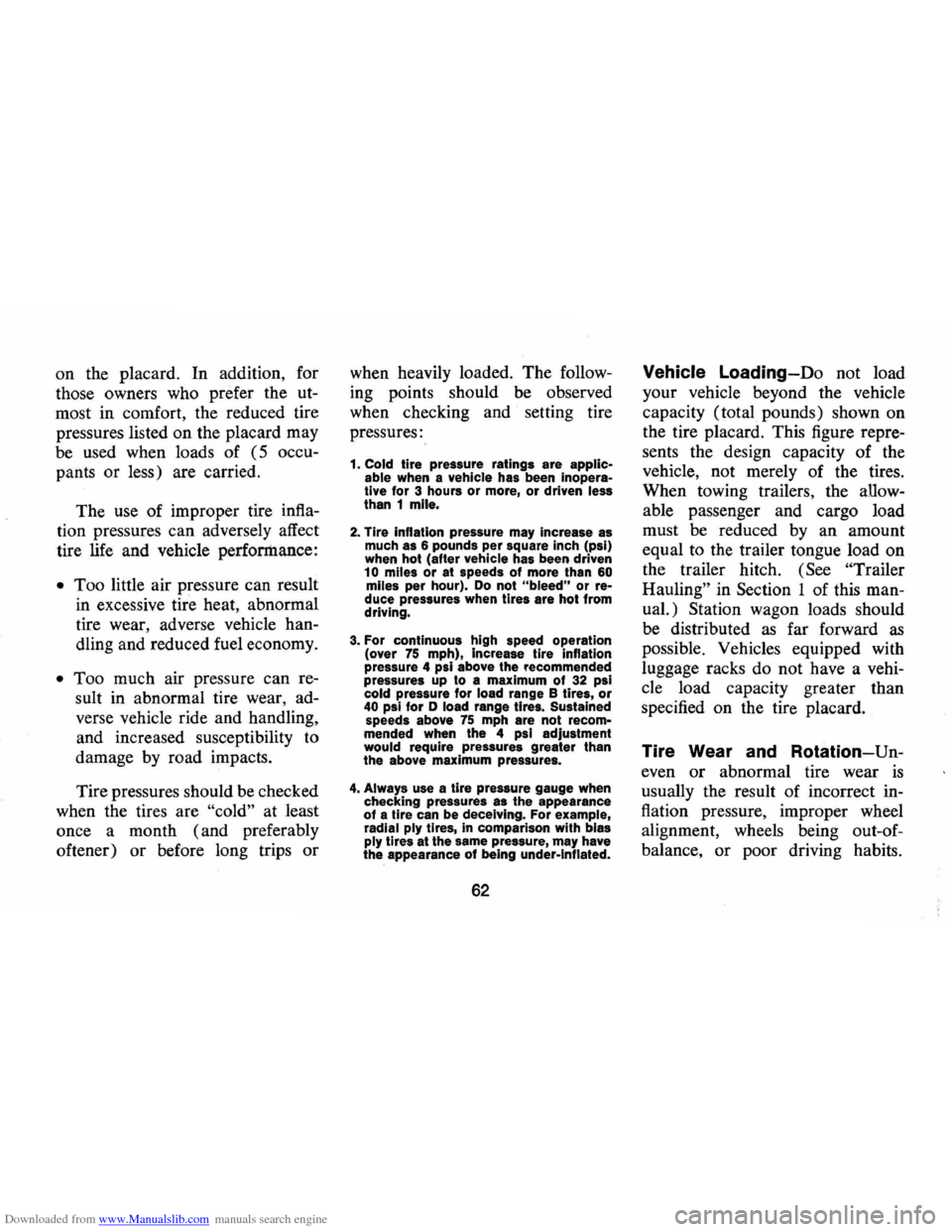wheel alignment CHEVROLET MONTE CARLO 1973 2.G Owners Manual
[x] Cancel search | Manufacturer: CHEVROLET, Model Year: 1973, Model line: MONTE CARLO, Model: CHEVROLET MONTE CARLO 1973 2.GPages: 86, PDF Size: 33.46 MB
Page 64 of 86

Downloaded from www.Manualslib.com manuals search engine on the placard. In addition, for
those owners who prefer the
ut
most in comfort, the reduced tire
pressures listed on the placard may
be used when loads of
(5 occu
pants or less) are carried.
The use of improper tire
infla
tion pressures can adversely affect
tire life and vehicle
perforrilance:
•
Too little air pressure can result
in excessive tire heat, abnormal
tire wear, adverse vehicle
han
dling and reduced fuel economy.
• Too much air pressure can re
sult in abnormal tire wear, ad
verse vehicle ride and handling,
and increased susceptibility to
damage
by road impacts.
Tire pressures should be checked
when the tires are
"cold" at least
once a month (and preferably
oftener)
or before long trips or
when heavily loaded. The follow
ing points should be observed
when checking and setting tire
pressures:
<
1. Cold tire pressure ratings are applic
able when a vehicle has been Inoperative for 3 hours or more, or driven less
than 1 mile.
2. Tire inflation pressure may increase as much as 6 pounds per square inch (psi)
when hot (after vehicle has been driven
10 miles or at speeds of more than 60 miles per hour). Do not "bleed" or reduce pressures when tires are hot from
driving.
3. For continuous high speed operation
(over 75 mph), increase tire inflation
pressure 4 psi above the fecommended
pressures up to a maximum
of 32 psi
cold pressure for load range B tires, or 40 psi for D load range tires. Sustained
speeds above 75 mph are not recom
mended when the 4 psi adjustment
would require pressures greater than
the above maximum pressures.
4. Always use a tire pressure gauge when
checking pressures as the appearance of a tire can be deceiving. For example,
radial ply tires, in comparison with bias
ply tires at the same pressure, may have
the appearance of being under-Inflated.
62
Vehicle Loading-Do not load
your vehicle beyond the vehicle
capacity (total pounds) shown on
the tire placard. This figure
repre
sents the design capacity of the
vehicle, not merely of the tires.
When towing trailers, the
allow
able passenger and cargo load
must be reduced by an amount
equal to the trailer tongue load on
the trailer hitch.
(See "Trailer
Hauling" in Section 1 of this man
ual.) Station wagon loads should
be distributed
as far forward as
possible. Vehicles equipped with
luggage racks do not have a
vehi
cle load capacity greater than
specified on the tire placard.
Tire Wear and Rotation-Un
even or abnormal tire wear is
usually the result of incorrect in
flation pressure, improper wheel
alignment, wheels being
out-of
balance, or poor driving habits.